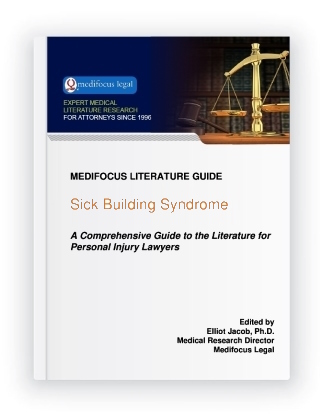Sick Building SyndromeA Comprehensive Guide to the Literature for Personal Injury Lawyers
Publisher: Medifocus Legal
Publication Date: January 26, 2024
Number of Pages: 78
A Comprehensive Guide to the Literature for Personal Injury Lawyers
Publisher: Medifocus LegalPublication Date: January 26, 2024
Number of Pages: 78
By definition, the signs and symptoms of sick building syndrome should be confined to occupants who work or live in an affected building; be detected in several individuals who experience these associated symptoms; and resolve when the affected occupants are not in the building. In contrast to building-related illness, such as Legionnaire's disease, sick building syndrome is not associated with any specific illness and, typically, a cause cannot be identified without conducting a thorough investigation.
When occupants of a building develop signs and symptoms consistent with sick building syndrome, management should be notified so that an appropriate investigation can be initiated. If management is unwilling or unable to perform an assessment to attempt to identify the underlying cause of the symptoms, the National Institute for Occupational Safety and Health (NIOSH) should be contacted for an evaluation.
Although there are many theories regarding the causes of sick building syndrome, the most commonly cited causes include inadequate ventilation, chemical contaminants from indoor sources such as those found inside a building (e.g., paint, adhesives, cleaning agents, carpeting), and chemical contaminants from outdoor sources such as exhaust from motor vehicles or industrial plants in the nearby area.
A cause of action in a sick building syndrome case generally is brought under: breach of contract, breach of express and implied warranties, negligence, strict liability, and personal injury. In addition to the usual personal injury damages, plaintiffs may seek recovery for intentional or negligent infliction of emotional distress, fear of future illness such as cancer or respiratory problems, or the need for future medical monitoring and/or treatment.
The MediFocus Literature Guide to Sick Building Syndrome captures a vast body of medical and scientific literature published in peer-reviewed journals regarding the symptoms and potential adverse health effects associated with inadequate ventilation, chemical contaminants, dampness, and mold in office buildings, schools, hospitals, and other indoor public places. This comprehensive literature Guide consists of over 100 hand-selected articles published in well respected journals with links to the article Abstracts and also includes online access to the full-text version of select articles. The Guide will serve as a valuable addition to the library of all personal injury attorneys involved in litigating sick building syndrome cases.
 |
- A comprehensive bibliography of 137 journal article references indexed in MEDLINE published in well respected medical and scientific journals.
- Online access to the abstracts (summaries) of the articles.
- A unique "Author Directory" consisting of the names and institutional affiliations of experts who have published and have specialized knowledge about Sick Building Syndrome. The "Author Directory" is a valuable resource for quickly identifying and locating experts for case reviews, opinions, and testimony.
Select examples of topics that are covered by the articles referenced in this Guidebook include:
- Prevalence of sick building syndrome in hospital staff and its relationship with indoor environmental quality.
- Associations between indoor CO2 concentrations and sick building syndrome symptoms in U.S. office buildings.
- Why do women suffer from sick building syndrome more often than men?--subjective higher sensitivity versus objective causes.
- Possible sources of sick building syndrome in a Tennessee middle school.
- Ocular, airway, and dermal symptoms related to building dampness and odors in dwellings.
- Studies on the role of fungi in Sick Building Syndrome.
- Office work exposures and respiratory and sick building syndrome symptoms.
- Sick building syndrome: psychological, somatic, and environmental determinants.
- Medical and social prognoses of non-specific building-related symptoms (Sick Building Syndrome): a follow-up study of patients previously referred to hospital.
- Quantitative relationship of sick building syndrome symptoms with ventilation rates.
- Molds, mycotoxins, and sick building syndrome.
- Office workers' sick building syndrome and indoor carbon dioxide concentrations.
- Dampness and moulds in workplace buildings: associations with incidence and remission of sick building syndrome (SBS) and biomarkers of inflammation in a 10 year follow-up study.
- Prevalence and risk factors of sick building syndrome among office workers.
- Work-related symptoms in indoor environments: a puzzling problem for the occupational physician.
- Effects of ventilation rate per person and per floor area on perceived air quality, sick building syndrome symptoms, and decision-making.
- Prevalence of sick building syndrome in hospital staff and its relationship with indoor environmental quality.
- Lifestyle behaviors and home and school environment in association with sick building syndrome among elementary school children: a cross-sectional study.
is available in two formats: | |
Order by Phone:To order by phone, please call: Order by Mail:To order by mail, please print and complete this Order Form | |

